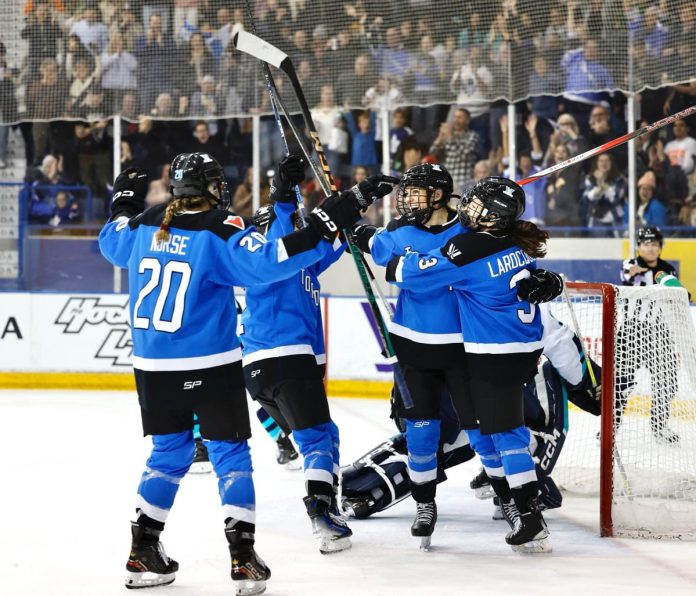Doris Burke made history as the first woman to serve as a television game analyst for a major men’s professional championship event, as she was on ESPN’s lead broadcast team for the NBA Finals between the Boston Celtics and the Dallas Mavericks.
Reflecting on her role, in an interview with Joe Reedy from the Associated Press, Burke stated: “I am sort of mindful that there is something meaningful here… if, in some way, this assignment makes life for women in sports easier or somehow aids in their process, then nothing could be more meaningful.”
In recent years, women have made big strides when it comes to sports broadcasting and competitive sports, breaking barriers in fields that are traditionally male-dominated.
There has been some progress and many challenges faced by women in these traditionally male-dominated fields: from increased media coverage and growing fan bases for leagues like the WNBA and PWHL, to the persistent gender disparities in pay and representation.
A 2021 study by the Associated Press Sports Racial and Gender Report Card, revealed that only 14.4 per cent of sports reporters were women, which was a slight increase from 11.5 per cent in 2018. This underrepresentation displays the ongoing challenges women face in aiming to make their voices heard within sports journalism.
While sports broadcasting has historically been dominated by males, women like Doris Burke are helping to change this narrative.
Peers and big-name athletes celebrated her groundbreaking accomplishment, with even LeBron James acknowledging the importance of the moment for the sport on X, quoting “Love and respect to DB and everything she does to elevate all of us!”
Despite key developments like Burke’s, gender disparities definitely still exist in professional sports leagues. However, the Professional Women’s Hockey League (PWHL) and the Women’s National Basketball Association (WNBA) have both experienced massive growth.
The WNBA, for instance, has seen record-breaking attendance and viewership. According to ESPN, with new superstars like Caitlyn Clark coming out of college. The 2024 season averaged 1.2 million viewers per game, with finals peaking at 1.6 million viewers. Some even call it the “Caitlyn Clark effect”.
This uptick in popularity has attracted significant investments from the league and investors and has led to a plan for league expansions, including the addition of the Golden State Valkyries and a plan is in the works for teams in Portland and Toronto by 2026. Similarly, the newly founded PWHL has also gained attention, reflecting a growing interest in women’s hockey.
Jane Young, a customer at Team Town Sports who was purchasing Toronto Sceptres PWHL gear, said: “I’m just excited to see jerseys in store! I’ve been waiting to get one, and for stores to carry merchandise and I’m super excited to be able to do so now.”
Young wasn’t the only one experiencing frustration, as many fans have expressed their frustration, whether online on Reddit forums, the struggle of in-store shopping trying to find merchandise, to begin with, or merchandise selling out almost instantly.
Clearly the demand is there, and the excitement surrounding these two up-and-coming leagues provides a positive trend toward a greater vision and support for women’s sports.
Historically, women’s sports have received only about four per cent of sports media coverage, but that’s with women accounting for nearly forty per cent of all athletes.
According to the Sports Business Journal, women’s sports now account for around 15 per cent of total sports media coverage, which can be credited to the growth of streaming platforms and prominence of social media in the modern day.
Increased visibility is key, as media coverage impacts sponsorship opportunities and financial support for some leagues. The WNBA’s fight for better pay is one of the bigger examples of issues.
While all players want a fair share of league revenue, Ralinda Watts from PopSugar.com notes that while NBA players receive about 50 per cent of league revenue, WNBA players receive only less than 25 per cent.
Addressing gaps like these is essential for the continual growth of women’s professional sports both for athletes, broadcasters and spectators.
Ann Pegoraro, a sports management professor at the University of Guelph and co-director of E-Alliance, Canada’s new Gender Equity in Sport Research Hub, acknowledged barriers that still need to be broken down, including at the Olympics.
Pegoraro states: “Despite equality in athlete numbers, the IOC has not made a similar push for gender parity within its own organization. Women within the IOC occupy only a third of the executive boards and only 37.5 per cent of committee positions.”
Looking at the bigger picture, it’s much bigger than just the women themselves in sports or on TV. The rise of women in sports broadcasting and the growing amount of women’s sports leagues directly has a huge impact on younger generations.
Increased visibility of female athletes and broadcasters provides such important role models for young girls knowing that can be them one day. Five years ago, they may not have had that dream.
The WNBA alone has inspired a ton of young fans. Increased game attendance and viewership, and access to games now televised among young females have led to higher participation rates in basketball.
Challenging societal norms that have historically discouraged them from pursuing sports is a powerful and strong message that should only continue to be encouraged.
Social movements advocating for gender equality have significantly influenced opportunities for women in sports, such as the #MeToo movement and increased awareness of gender disparities. Leagues like the WNBA have been right in view of social justice activism, addressing issues recently like getting out to vote in the election.
When watching big events like the Olympics, Pegoraro suggests that “while we are cheering on the Olympians during the Games, let’s also be looking for ways to create real systemic change to effect true equity in sport – this is the true gold medal goal.”
Overall, the journey of women breaking boundaries in sports broadcasting and competitive sports reflects important progress while still dealing with ongoing challenges and change.
Increased representation and support have created new visions, and equality requires continued efforts to look at funding, media coverage, and societal issues.
The impact on younger kids is one of the most important aspects of the recent uptick in women’s representation, as they get to see and can be inspired by female role models in sports.
One day, it could be them, and that’s a vision that anyone with a dream should have the chance to pursue.




